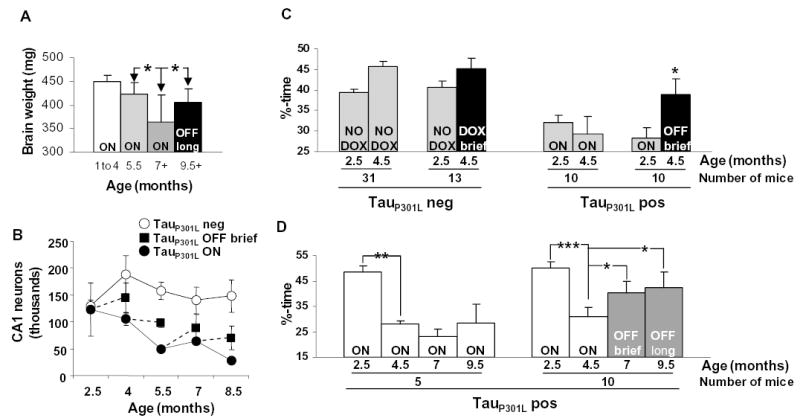Fig. 3.

Neuron death ceases and memory recovers when transgenic tau expression is suppressed. (A) Brain weights in 9.5- to 10-month-old tauP301L-positive mice exposed to doxycycline for 4.5 months were significantly higher than brain weights in 7-month-old tauP301L-positive mice but were not higher than those of tauP301L-positive mice at 5.5 months, the age at which doxycycline was initiated. *P < 0.01. (B) CA1 neuron numbers in one hemisphere were estimated and found to stabilize after doxycycline treatment. (C) Twenty mice with target quadrant occupancies <39.5%, making up the half of a 2.5-month-old cohort having lower performance ratings, were tested in the water maze a second time at 4.5 months in the presence (n = 10) or absence of doxycycline (n = 10), which was initiated at 2.5 months. In tauP301L-positive mice, memory recovered significantly when transgenic tau was suppressed. In tauP301L-negative mice with target quadrant occupancies in the half of a cohort at 2.5 months of age having lower performance ratings in the presence (n = 13) or absence (n = 31) of doxycycline, a trend toward improved performance at 4.5 months was due to regression toward the mean (~48% in tauP301L-negative mice), as the trend was not apparent when the complete cohort was examined. *P < 0.05. (D) Memory was tested longitudinally at four ages in 15 mice in the top performing half of their cohort at 2.5 months of age (target quadrant occupancies >39.5%). Doxycycline was administered at 5.5 months to 10 mice, and control feed was administered to 5 mice. Significant improvements were found in tauP301L-positive mice treated with doxycycline, but not in tauP301L-positive mice maintained on the control diet. *P < 0.05, **P < 0.01, ***P < 0.0001.
